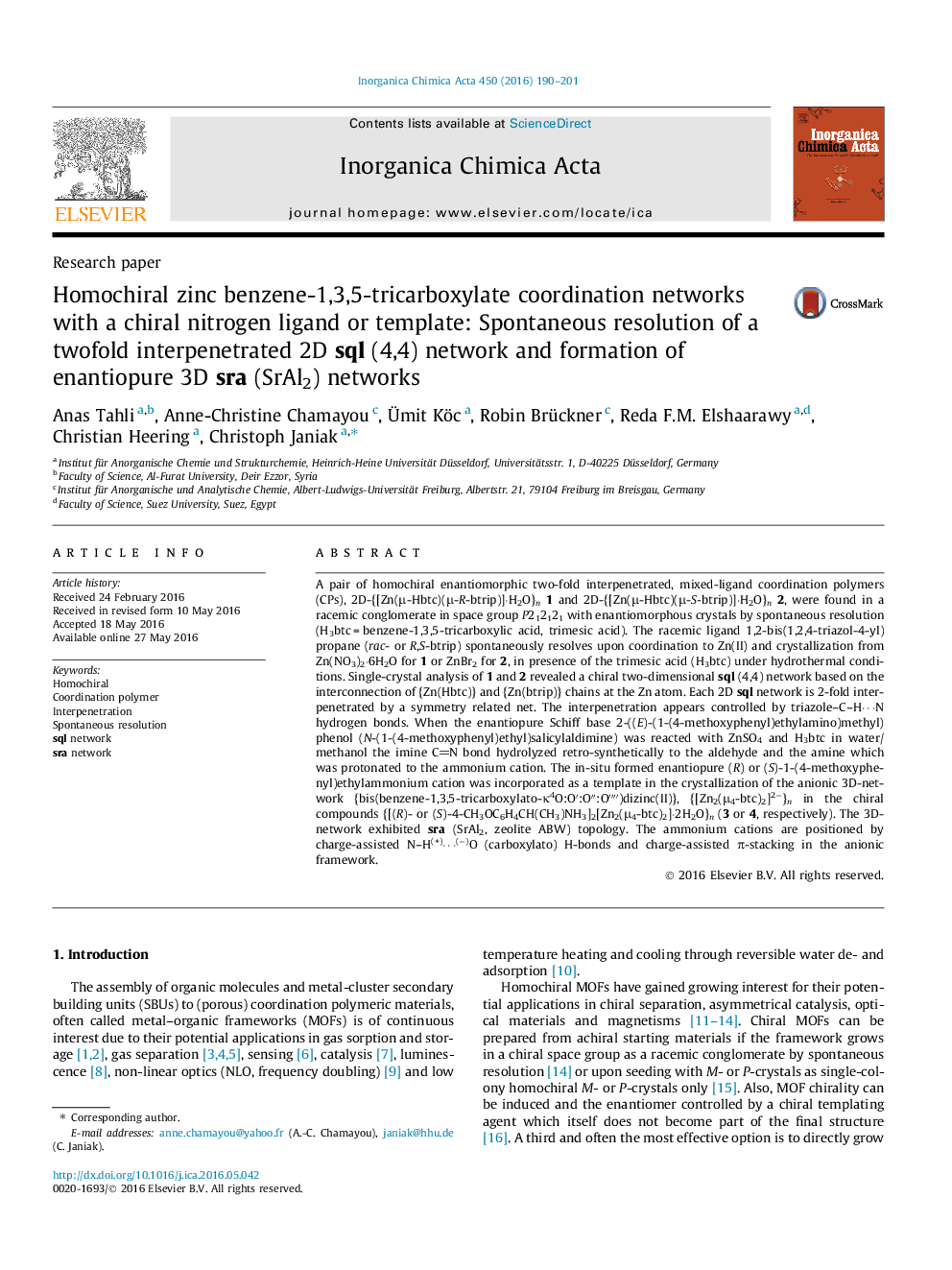| Article ID | Journal | Published Year | Pages | File Type |
|---|---|---|---|---|
| 1305387 | Inorganica Chimica Acta | 2016 | 12 Pages |
•Spontaneous resolution of coordination polymer synthesized with racemic ligand.•Formation of chiral mixed-ligand, two-dimensional, two-fold interpenetrated sql network.•In-situ, retro-synthetic hydrolysis of chiral Schiff base ligand to chiral amine.•Chiral protonated amine templates new 3D-zinc-btc network of sra (SrAl2) topology.•Crystal structures of both enantiomers determined.
A pair of homochiral enantiomorphic two-fold interpenetrated, mixed-ligand coordination polymers (CPs), 2D-{[Zn(μ-Hbtc)(μ-R-btrip)]·H2O}n1 and 2D-{[Zn(μ-Hbtc)(μ-S-btrip)]·H2O}n2, were found in a racemic conglomerate in space group P212121 with enantiomorphous crystals by spontaneous resolution (H3btc = benzene-1,3,5-tricarboxylic acid, trimesic acid). The racemic ligand 1,2-bis(1,2,4-triazol-4-yl)propane (rac- or R,S-btrip) spontaneously resolves upon coordination to Zn(II) and crystallization from Zn(NO3)2·6H2O for 1 or ZnBr2 for 2, in presence of the trimesic acid (H3btc) under hydrothermal conditions. Single-crystal analysis of 1 and 2 revealed a chiral two-dimensional sql (4,4) network based on the interconnection of {Zn(Hbtc)} and {Zn(btrip)} chains at the Zn atom. Each 2D sql network is 2-fold interpenetrated by a symmetry related net. The interpenetration appears controlled by triazole–C–H⋯N hydrogen bonds. When the enantiopure Schiff base 2-((E)-(1-(4-methoxyphenyl)ethylamino)methyl)phenol (N-(1-(4-methoxyphenyl)ethyl)salicylaldimine) was reacted with ZnSO4 and H3btc in water/methanol the imine CN bond hydrolyzed retro-synthetically to the aldehyde and the amine which was protonated to the ammonium cation. The in-situ formed enantiopure (R) or (S)-1-(4-methoxyphenyl)ethylammonium cation was incorporated as a template in the crystallization of the anionic 3D-network {bis(benzene-1,3,5-tricarboxylato-κ4O:O′:O″:O‴′)dizinc(II)}, {[Zn2(μ4-btc)2]2−}n in the chiral compounds {[(R)- or (S)-4-CH3OC6H4CH(CH3)NH3]2[Zn2(μ4-btc)2]·2H2O}n (3 or 4, respectively). The 3D-network exhibited sra (SrAl2, zeolite ABW) topology. The ammonium cations are positioned by charge-assisted N–H(+)⋯(−)O (carboxylato) H-bonds and charge-assisted π-stacking in the anionic framework.
Graphical abstractHomochiral MOFs by spontaneous resolution or by chiral templating are presented in both enantiomeric forms each. In both cases hydrogen bonding appears to control either the interpenetration or templating action.Figure optionsDownload full-size imageDownload as PowerPoint slide
